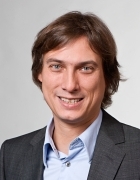
Prof. Dr. Friedrich Simmel
Academic Career and Research Areas
The research conducted by Prof. Simmel (b. 1970) revolves around bionanotechnology and the physics of synthetic biological systems. His particular areas of interest include artificial molecular machines and nanostructures composed of DNA molecules and the design of artificial biochemical circuits.
After studying physics and completing his doctorate (1999) at Munich’s Ludwig Maximilian University (LMU), he did research work at Bell Laboratories in Murray Hill, NJ, USA. He returned to LMU in 2002 to work in a junior research group sponsored by the German Research Foundation’s Emmy Noether program. In 2005, Prof. Simmel qualified as a lecturer in experimental physics at LMU. He has been Chair of Experimental Physics (Physics of Synthetic Biological Systems) at TUM since 2007. Since 2013, Prof. Simmel has been a member of acatech - the National Academy of Science and Engineering.
Awards
- ERC Advanced Grant (2015)
- Human frontier science program (HFSP) young investigator award (2006)
- DFG Emmy Noether Early Career Researcher (2002)
Key Publications (all publications)
Kopperger E, List J, Madhira S, Rothfischer F, Lamb DC, Simmel FC: "A self-assembled nanoscale robotic arm controlled by electric fields". Science. 2018; 359(6373): 296-301.
AbstractPardatscher G, Bracha D, Daube SS, Vonshak O, Simmel FC, Bar-Ziv RH: "DNA condensation in one dimension". Nature Nanotechnology. 2016; 11(12): 1076-81.
AbstractWeitz M, Kim J, Kapsner K, Winfree E, Franco E, Simmel FC: "Diversity in the dynamical behaviour of a compartmentalized programmable biochemical oscillator". Nature Chemistry. 2014; 6(4): 295-302.
AbstractLangecker M, Arnaut V, Martin TG, List J, Renner S, Mayer M, Dietz H, Simmel FC: "Synthetic lipid membrane channels formed by designed DNA nanostructures". Science. 2012; 338(6109): 932-936.
AbstractKuzyk A, Schreiber R, Fan Z, Pardatscher G, Roller EM, Högele A, Simmel FC, Govorov AO, Liedl T: "DNA-based self-assembly of chiral plasmonic nanostructures with tailored optical response". Nature. 2012; 483(7389): 311-314.
AbstractIf you wish your profile to be changed or updated please contact Franz Langer.